This in-depth exploration of the world of marination is more than just a guide; it's your culinary compass for exploring the nuances of flavoring and safely storing marinated chicken.
Inspired by my flavorful Huli Huli Homemade Sauce Recipe for Chicken, this comprehensive guide will cover everything from marination to food safety, ensuring every chicken dish you prepare is delicious and safe. Let's dive in!
Jump to:
- What Is Marination?
- Marinating Different Chicken Cuts
- Essentials of Marinating Chicken: Techniques for Flavor and Safety
- Choosing the Best Storage Method
- Tips for Perfect Marination
- Cooking Marinated Chicken
- Identifying Spoiled Marinated Chicken
- Debunking Marination Myths
- FAQ
- The Science and Art of Marinades
- Conclusion
- Chicken Recipes You May Like
- Pairing
- 💬 Reviews
What Is Marination?
Marination is a culinary technique involving soaking foods, especially meats like chicken, in a flavorful liquid - the marinade. This process not only gives the chicken delectable flavors but also tenderizes it, enhancing the texture of the meat. Typical marinade ingredients include acidic components like lemon juice or vinegar, oils such as olive oil, and a variety of spices and herbs. This magical concoction works wonders, turning ordinary chicken pieces into a mouthwatering feast.
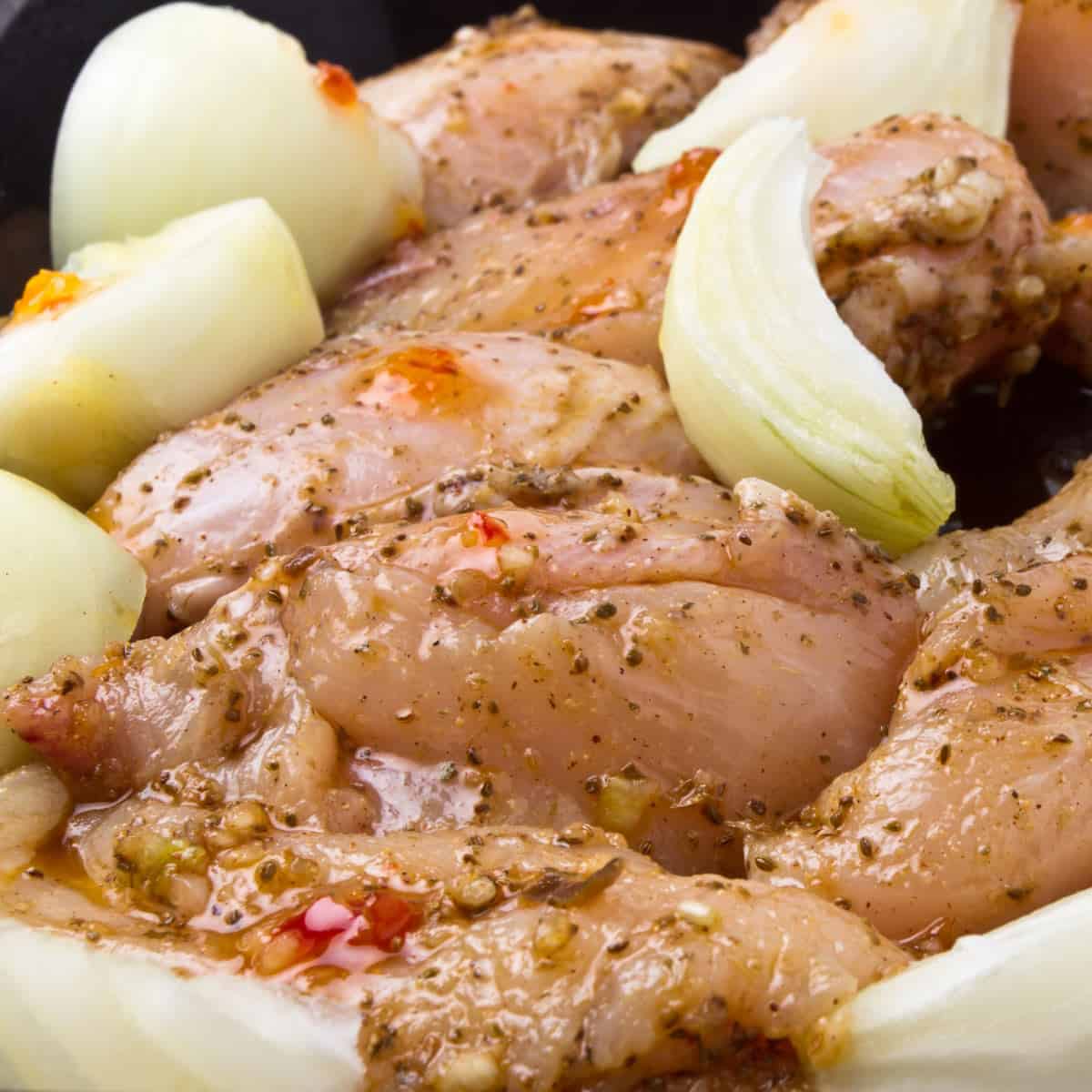
Marinating Different Chicken Cuts
Each cut of chicken, from whole chicken to chicken wings, has unique characteristics. Here’s a quick guide:
- Chicken Breast: Lean and prone to drying, chicken breasts benefit from shorter marination times in acidic marinades.
- Thighs and Drumsticks: These fattier cuts can handle longer marination times, allowing flavors to penetrate deeply.
- Wings and Tenderloins: These cuts absorb flavors rapidly for quicker marination and are great for quick meal prep.
Chicken pieces like breasts and tenderloins need shorter marinating times, typically 2-4 hours. Thicker cuts like thighs and drumsticks can be marinated longer, up to 12 hours, for the best flavor infusion.
Essentials of Marinating Chicken: Techniques for Flavor and Safety
Marinating chicken, whether it's fresh chicken or frozen chicken thawed in cold water, is an art that involves more than just soaking the meat in a good marinade. To achieve the best results in both taste and food safety, consider these key points:
- Balanced Ingredient Mix: A well-crafted marinade is a symphony of flavors. It's about finding the right harmony between acidic components (like lemon or lime juice), oils (such as olive oil), and aromatic herbs and spices. Each ingredient plays a pivotal role in imparting flavor and tenderizing the meat.
- Optimal Marination Time: Different cuts require different marinating times. Chicken breasts and tenderloins, known for their lean texture, should marinate for 2-4 hours. This is enough time to infuse flavor without the risk of the acidic components, such as citrus juice, breaking down the texture of the meat. For chicken thighs and drumsticks, which are richer in fat, extending the marination time to 12 hours allows flavors to penetrate more deeply, ensuring a delicious meal.
- Avoiding Over-Marination: It's important not to let chicken marinate too long, especially in acidic marinades, as this can lead to a mushy texture. This is crucial for maintaining the best quality and ensuring the chicken retains its desired texture.
- Refrigeration is Key: To avoid bacterial growth or the risk of foodborne illness, never marinate chicken at room temperature. Always use the refrigerator, keeping the marinating chicken in an airtight container or a sealed zip-top bag for the best results.
- Right Marinating Containers: When marinating, use non-reactive containers like glass or stainless steel bowls. Reactive containers, like those made of aluminum, can interact with acidic marinade ingredients, such as vinegar or lemon juice, and alter the taste and safety of the food.
Choosing the Best Storage Method
When deciding between refrigerating or freezing marinated chicken, the choice largely depends on your intended use and timeline. Both methods have their advantages and considerations:
Refrigerating Marinated Chicken
- Short-Term Use: Refrigeration is ideal if you plan to cook the chicken within a short period, typically within 1-2 days. This method keeps the chicken fresh and ready to cook without additional prep time.
- Flavor Development: Marinating chicken in the refrigerator melds the flavors and penetrates the meat over time. This gradual process can result in more evenly flavored and tender meat.
- Convenience: Refrigerated marinated chicken is more convenient if you’re planning a meal within the next day or two. There's no need to account for thawing time.
Freezing Marinated Chicken
- Long-Term Storage: Freezing is the better choice for long-term storage. Marinated chicken can be frozen in freezer bags (to avoid freezer burn) for up to three months, making it a great option for meal prep or to marinate in bulk.
- Quality Preservation: Freezing halts bacterial growth and preserves the quality of the chicken over a longer period. However, the texture of the meat might be slightly affected upon thawing.
- Thawing Requirement: When you're ready to use frozen marinated chicken, you’ll need to plan for thawing. The safest methods are in the refrigerator or cold water, but these methods add to your prep time.
Considerations for Both Methods
- Food Safety: With both refrigerating and freezing, it's crucial to store the chicken at safe temperatures to prevent bacterial growth and reduce the risk of foodborne illness.
- Container Use: When refrigerating or freezing chicken, use airtight containers or zip-top freezer bags to preserve the flavors and prevent contamination.
Tips for Perfect Marination
- Balance in Ingredients: A good marinade balances acidic ingredients like citrus juice or vinegar with oils and seasonings. This ensures the chicken is flavored without being overpowered.
- Marinating Containers: Opt for glass containers or stainless steel bowls.
- Safe Handling: Always marinate chicken in the refrigerator and use a separate airtight container to avoid cross-contamination.
- Reusing Marinades: If you plan to use the marinade as a sauce later, a good thing to do is to boil the marinate first to kill any bacteria from the raw meat.
- Marinade Time: Tender cuts like chicken breasts need only a few hours of marinating. However, tougher cuts like thighs can benefit from longer marinating times.
Cooking Marinated Chicken
When it's time to cook, remember the golden rule: the internal temperature of the chicken should reach 165°F. This ensures the chicken is cooked thoroughly and is safe to eat. Always use a food thermometer to check the temperature, whether you’re grilling, baking, or pan-frying.
Identifying Spoiled Marinated Chicken
When dealing with marinated chicken, whether stored in the fridge or thawed from frozen chicken, recognizing signs of spoilage is crucial for preventing foodborne illness. Here’s how to identify if your marinated chicken is no longer safe to consume:
- Offensive Odor: A key indicator of spoiled marinated chicken is an unpleasant, sour smell. Fresh chicken, even when marinated, should have a mild scent. If you detect any foul or off odors, it's a sign of bacterial growth, and the chicken should be discarded.
- Texture Changes: Spoiled marinated chicken often develops a slimy or sticky texture. While some marinades, especially those with olive oil or citrus juice, can slightly change the texture of the meat, it should never feel slippery or gooey. If the chicken feels unusually slimy after rinsing off the marinade, it's a sign of spoilage.
- Visual Cues: Look for any unusual color changes or mold on the chicken. Fresh marinated chicken should retain its natural color, slightly altered by the ingredients of the marinade, such as soy sauce or lemon juice. Any grayish hue, green spots, or visible mold indicates that the chicken has gone bad.
- Expiry Dates: Always consider the sell-by or use-by date of the chicken before marinating it. Even the best marinade can't make spoiled raw chicken safe to eat. The shelf life of marinated chicken in the fridge is typically 1-2 days; beyond that, the risk of bacterial growth increases.
- Storage Conditions: How the chicken was stored plays a crucial role. Chicken marinated in a sealed container or zip-top bag and kept at a safe temperature (below 40°F in the fridge) has a lower risk of spoiling compared to chicken left out at room temperature or improperly sealed.
- Tainted Marinades: If the marinade itself has ingredients that can spoil quickly (like fresh herbs or coconut milk), it can shorten the safe usage window of the marinated chicken. A good marinade should add flavor and help preserve the chicken for a short time.
Debunking Marination Myths
Myth #1: The More, The Better
Not necessarily. A good marinade needs balance. Too much acid can toughen the meat.
Myth #2: Marinating at Room Temperature Speeds Up the Process
This is dangerous and can lead to bacterial breeding grounds. Always marinate in the fridge.
Myth #3: Freezing Stops the Marinating Process
Partially true. While freezing slows it down, the marinating process continues, albeit at a slower pace.
FAQ
Fresh chicken can typically be stored in the refrigerator for 1-2 days before marinating. Always check the sell-by date for the best quality and safety.
Yes, using a zip-top bag is not only safe but also effective. It allows the marinade to cover the chicken evenly and minimizes the need for a large container.
Reusing marinade that has been in contact with raw chicken is not recommended unless it's boiled first. Boiling the marinade can kill harmful bacteria, making it safe for later use as a sauce or glaze.
The safest method is to thaw it in the refrigerator. Avoid thawing at room temperature, as this can lead to bacterial growth. You can also use cold water for faster thawing, changing the water every 30 minutes.
It's better to thaw chicken before marinating to ensure even flavor absorption. If you marinate while frozen, the process will be uneven and less effective.
The safest way to check is using a food thermometer. The internal temperature of the chicken should reach 165°F to ensure it's fully cooked and safe to eat.
Never marinate chicken at room temperature; it can become a breeding ground for harmful bacteria. Always marinate in the refrigerator.
While acidic ingredients are great for flavor and tenderizing, over-marinating (especially in highly acidic marinades) can make the meat tough. It's important to marinate for just the right amount of time.
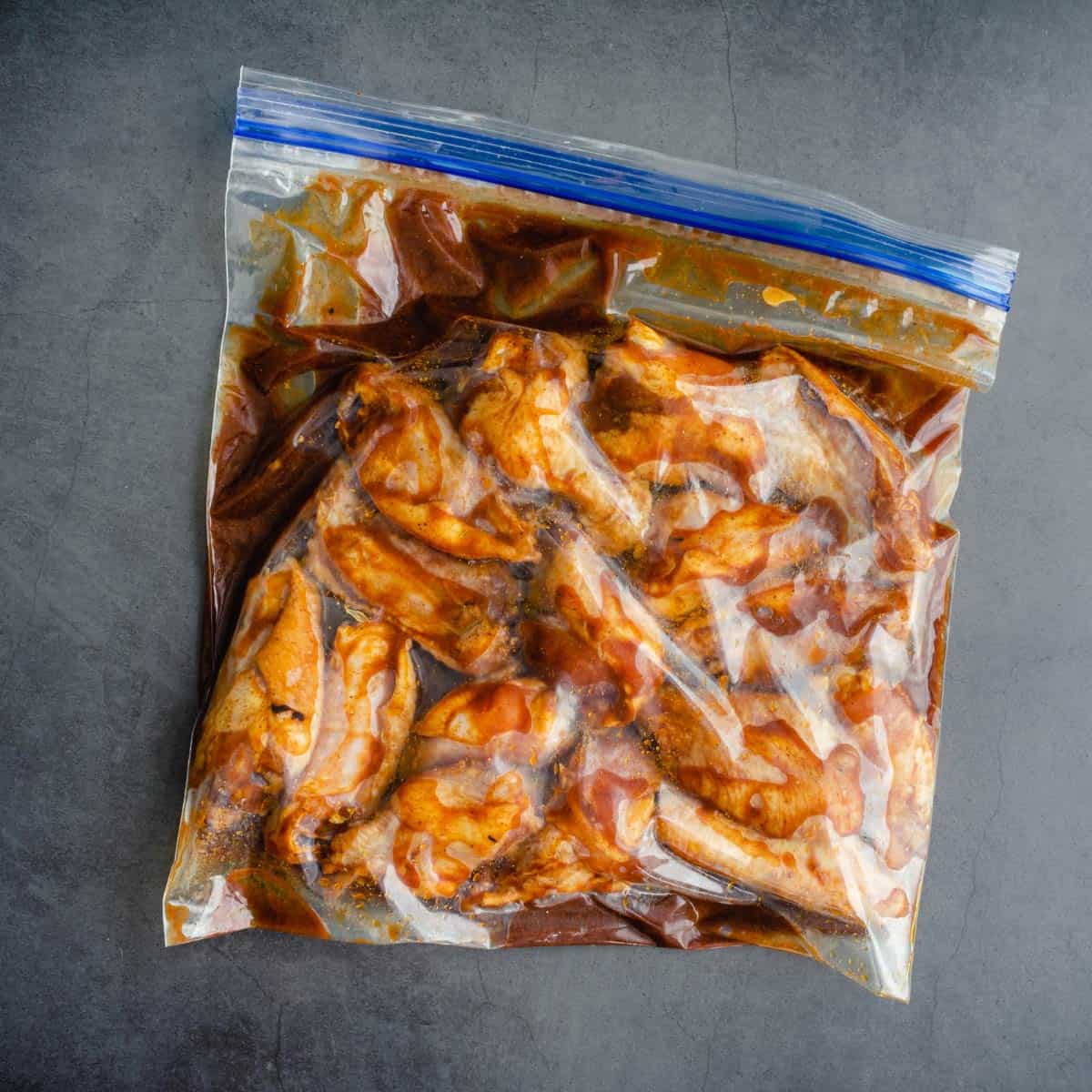
The Science and Art of Marinades
Marinating chicken is a perfect blend of science and culinary artistry, a process that transforms simple chicken pieces into a culinary delight. Let's explore how various ingredients and techniques come together to create a delicious marinade:
Chemical Tenderization: Acidic ingredients like lemon juice or vinegar in marinades break down proteins, tenderizing the meat. In the Huli Huli Homemade Sauce Recipe for Chicken, pineapple juice not only adds a tropical sweetness but also contains enzymes that tenderize the chicken, enhancing the texture of the meat.
Flavor Infusion: A marinade’s main purpose is to infuse the chicken with flavor. Ingredients like soy sauce and brown sugar create a savory-sweet dynamic, penetrating the meat and giving it a distinct taste. Adding garlic and ginger introduces aromatic flavors, elevating the overall taste of the chicken.
Moisture Retention: Olive oil or other oils in marinades help retain moisture in the meat, which is especially important for lean cuts like chicken breasts. Oils carry fat-soluble flavors from spices and herbs, evenly coating the chicken and preventing it from drying during cooking.
Marinade Composition: Balancing acidic components, oils, and seasonings is crucial. My Huli Huli marinade showcases this balance, combining pineapple juice (acidic), soy sauce (salty and umami), and a hint of ginger (spicy), creating a complex flavor profile.
Health and Nutrition: Ingredients like fresh herbs, citrus juice, and olive oil add flavor and offer health benefits. They can introduce antioxidants and beneficial compounds to the chicken, making your meal tasty and nutritious.
Time and Temperature: Marinating should be done in the refrigerator to prevent bacterial growth. The time can vary; typically, 2-4 hours is sufficient for chicken pieces, while longer durations may be needed for tougher cuts or for flavors to develop fully.
Safety Considerations: It is paramount to use fresh chicken and follow food safety guidelines, like ensuring the chicken reaches an internal temperature of 165°F when cooked. Always discard leftover uncooked marinade or boil it before using it as a sauce to avoid contamination.
Conclusion
Marinating chicken is a journey of flavors and textures, essential for any culinary enthusiast. By understanding the essentials of marination, debunking myths, ensuring proper storage and safety, and embracing the science and art behind it, we can elevate our chicken dishes from good to extraordinary. Remember, the key is to balance flavors, time, and safety.
Remember these guidelines for a delicious and safe culinary experience as you experiment with marinades. And don’t forget to try my easy Huli Huli Homemade Sauce recipe for an unforgettable chicken dish!
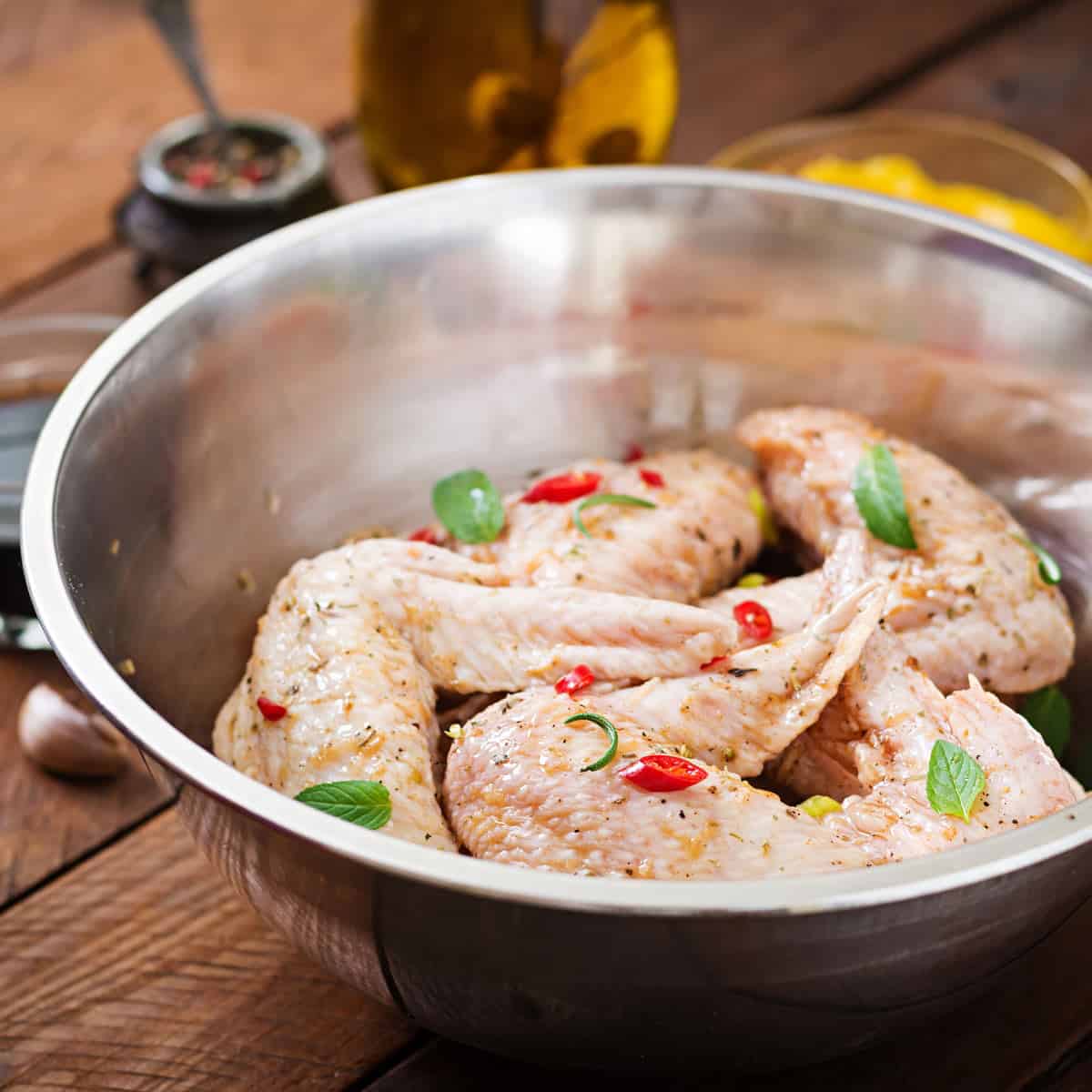
Instructions
Refrigerating
- Short-Term Use: Refrigeration is ideal if you plan to cook the chicken within a short period, typically within 1-2 days.
- Flavor Development: Marinating chicken in the refrigerator melds the flavors and penetrates the meat over time.
- Convenience: Refrigerated marinated chicken is more convenient if you’re planning a meal within the next day or two.
Freezing
- Long-Term Storage: Freezing is the better choice for long-term storage. Marinated chicken can be frozen in freezer bags (to avoid freezer burn) for up to three months, making it a great option for meal prep or to marinate in bulk.
- Quality Preservation: Freezing halts bacterial growth and preserves the quality of the chicken over a longer period.
- Thawing Requirement: When you're ready to use frozen marinated chicken, you’ll need to plan for thawing. The safest methods are in the refrigerator or cold water, but these methods add to your prep time.
Notes
- Food Safety: With both refrigerating and freezing, it's crucial to store the chicken at safe temperatures to prevent bacterial growth and reduce the risk of foodborne illness.
- Container Use: When refrigerating or freezing chicken, use airtight containers or zip-top freezer bags to preserve the flavors and prevent contamination.
Chicken Recipes You May Like
Looking for chicken recipes? Try these:
Pairing
These are my favorite dishes to serve with chicken:















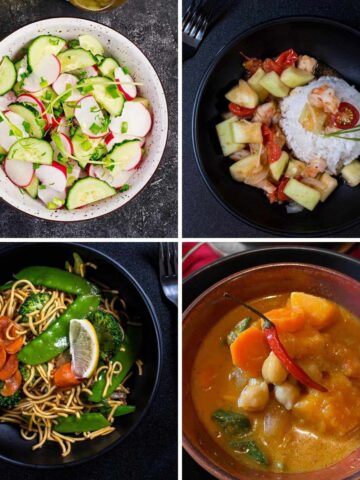
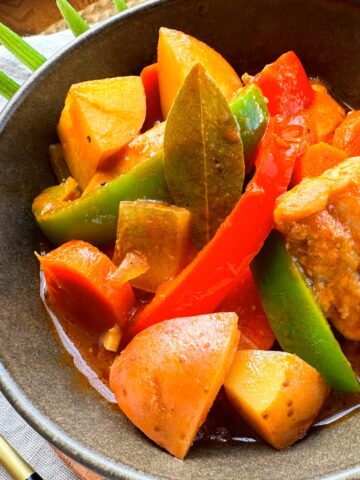


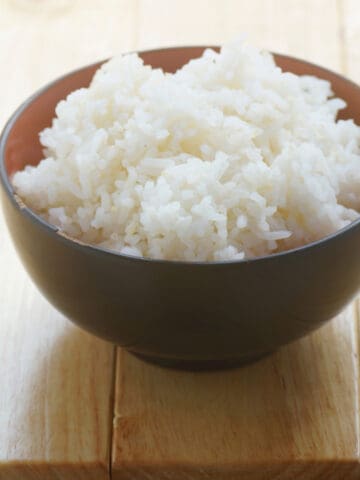
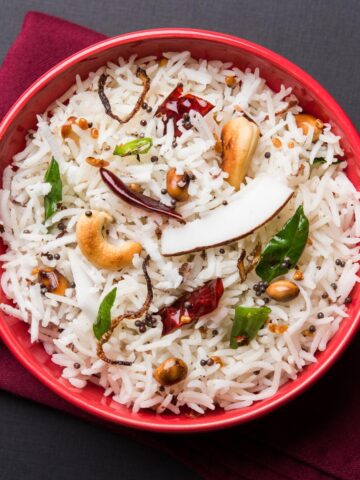

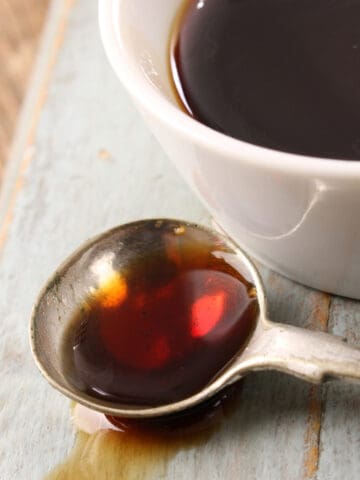



Comments
No Comments